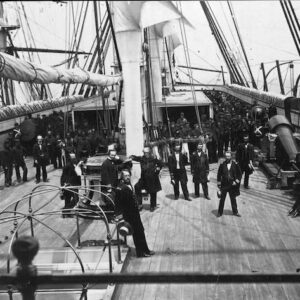Tag: Rodgers (John)
 U.S.S. Vermont.
U.S.S. Vermont.
Library of Congress says: Capt. John Rodgers, officer of the Federal Navy (Commodore from June 17, 1863).
Wikipedia says: John Rodgers (August 8, 1812 – May 5, 1882) was an admiral in the United States Navy. He began his naval career as a commander in the American Civil War and during his Postbellum service became an admiral.
…Commander Rodgers’ first war assignment was to go with Commodore Louis M. Goldsborough to Gosport Navy Yard on April 20, 1861, where with other officers he was to remove Naval vessels and assets so they could not be used by the Confederates. Virginia had only just declared her secession from the Union. Upon arrival they found the yard in shambles, as Commodore McCauley had already ordered the vessels at Gosport scuttled, including the Merrimack, since he considered the yard indefensible. Commodore Goldsborough made the decision to destroy the yard, and Commander Rodgers and Army Captain of Engineers Horatio G. Wright were given the job of destroying the drydock. They were thwarted in this attempt when the fuse was extinguished by water in the pumping gallery. Commander Rodgers and Captain Wright were captured by General William B. Taliaferro of the Virginia State Militia, but since Virginia had not yet joined the Confederate States, and was therefore not at war against the United States, Governor John Letcher returned the two officers to Washington.
Commander Rodgers was then sent to the Western Rivers, where he organized the Western Flotilla and supervised construction of the City-class gunboats, the first ironclad gunboats on the western rivers. He was relieved by Captain Andrew Hull Foote, a more senior officer being required by the Navy to deal with the prickly Major General John C. Fremont. After blockading operations off of Savannah in command of the Flag, he assumed command of the experimental ironclad Galena in April 1862, operating with distinction in the James River. He commanded the James River Flotilla, including the USS Galena, the ironclad Monitor, and the 90-day gunboat Aroostook in an expedition up the James River in May 1862, which was stopped eight miles shy of Richmond by Confederate fortifications at Drewry’s Bluff. The damage that the Galena suffered in the ensuing battle caused him to report, “We demonstrated that she is not shotproof”, and made him disdainful of trying experiments in the fires of war. Thereafter he supported General McClellan’s Peninsula Campaign with Naval bombardment, preventing Confederate forces from overrunning the Army of the Potomac’s position.
John Rodgers was promoted to captain July 16, 1862 and took command of the ironclad monitor Weehawken. After successfully navigating her from Brooklyn to Charleston through the same storm that sank the USS Monitor, he distinguished himself during the attack on Fort Sumter in May 1863, and in capturing the Confederate ram Atlanta on June 17, 1863. The latter service won him the Thanks of Congress and promotion to commodore. Unfortunately, this was his last active service in the Civil War. After recovering from an illness, he took command of the ironclad monitor Dictator. Design and construction problems with that vessel kept him occupied for the remainder of the war, though he earnestly desired a more active post.
Showing the single result
